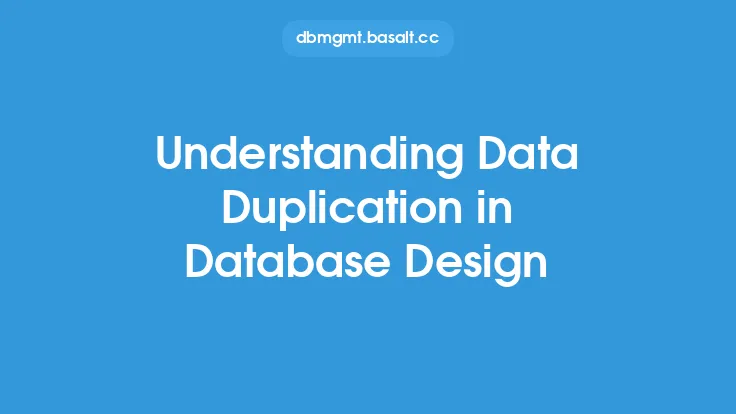Implementing data access controls is a critical aspect of database design, as it ensures that sensitive data is protected from unauthorized access, modification, or deletion. Data access controls are mechanisms that regulate who can access, modify, or delete data in a database, and they are essential for maintaining data integrity, confidentiality, and availability. In this article, we will delve into the world of data access controls, exploring their importance, types, and implementation strategies in database design.
Importance of Data Access Controls
Data access controls are vital for several reasons. Firstly, they prevent unauthorized access to sensitive data, reducing the risk of data breaches and cyber attacks. Secondly, they ensure that data is modified or deleted only by authorized personnel, maintaining data integrity and consistency. Thirdly, they enable organizations to comply with regulatory requirements, such as GDPR, HIPAA, and PCI-DSS, which mandate the protection of sensitive data. Finally, data access controls help organizations to maintain data quality, as they prevent unauthorized modifications or deletions that can compromise data accuracy and reliability.
Types of Data Access Controls
There are several types of data access controls, including:
- Authentication: verifies the identity of users, ensuring that only authorized personnel can access the database.
- Authorization: determines the level of access granted to users, based on their roles, responsibilities, or permissions.
- Access Control Lists (ACLs): define the permissions and access rights for users or groups, controlling what actions they can perform on specific data objects.
- Row-Level Security (RLS): restricts access to specific rows or data sets, based on user identity, role, or other factors.
- Column-Level Security: restricts access to specific columns or data fields, based on user identity, role, or other factors.
- Encryption: protects data at rest or in transit, using algorithms and keys to ensure confidentiality and integrity.
Implementing Data Access Controls
Implementing data access controls requires a thorough understanding of database design principles, as well as the organization's security and compliance requirements. The following steps can help organizations implement effective data access controls:
- Conduct a risk assessment: identify sensitive data assets, potential threats, and vulnerabilities.
- Define access control policies: establish clear policies and procedures for data access, modification, and deletion.
- Design a role-based access control (RBAC) model: assign roles and permissions to users, based on their job functions and responsibilities.
- Implement authentication and authorization mechanisms: use techniques such as username/password, multi-factor authentication, or Kerberos to verify user identity.
- Configure access control lists (ACLs): define permissions and access rights for users or groups, using SQL grants, denies, or revokes.
- Enable row-level security (RLS) and column-level security: use database features, such as Oracle's Virtual Private Database or SQL Server's Row-Level Security, to restrict access to sensitive data.
- Encrypt sensitive data: use encryption algorithms, such as AES or RSA, to protect data at rest or in transit.
Database Design Considerations
When designing a database with data access controls, several factors must be considered:
- Data modeling: ensure that the data model accurately reflects the organization's data assets and relationships.
- Schema design: design a schema that supports data access controls, using techniques such as separate schemas for sensitive data or views to restrict access.
- Indexing and partitioning: optimize indexing and partitioning strategies to improve query performance, while maintaining data access controls.
- Auditing and logging: implement auditing and logging mechanisms to track data access, modifications, and deletions.
Best Practices for Data Access Controls
To ensure effective data access controls, organizations should follow best practices, such as:
- Least privilege principle: grant users only the necessary permissions and access rights to perform their job functions.
- Separation of duties: separate duties and responsibilities to prevent a single user from having excessive access or control.
- Regular security audits: perform regular security audits to identify vulnerabilities and ensure compliance with regulatory requirements.
- Data access control reviews: review data access controls regularly to ensure they remain effective and aligned with organizational policies.
Conclusion
Implementing data access controls is a critical aspect of database design, as it ensures the confidentiality, integrity, and availability of sensitive data. By understanding the importance, types, and implementation strategies of data access controls, organizations can design and implement effective controls that meet their security and compliance requirements. By following best practices and considering database design factors, organizations can maintain the trust and confidence of their customers, partners, and stakeholders, while protecting their sensitive data assets.





